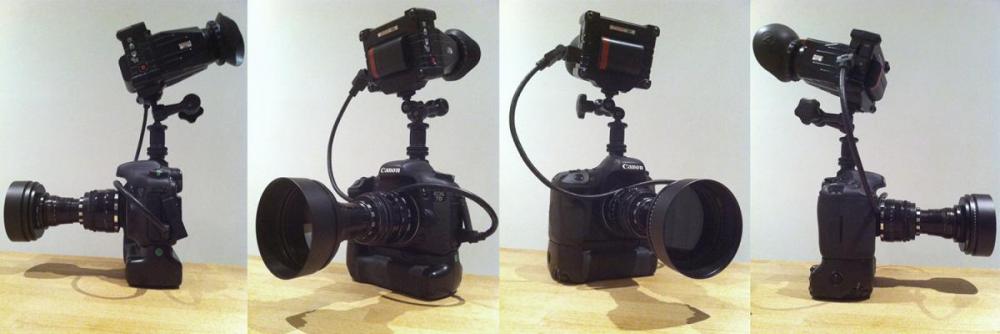Leaderboard
Popular Content
Showing content with the highest reputation on 02/07/2013 in all areas
-

Metabones Speed Booster review
BydrodoFieddy reacted to Andrew Reid for a topic
http://vimeo.com/57901943 Buy the E-mount Metabones Speed Booster - $599 for Canon EOS lens adapter, $399 for others The Metabones Speed Booster adapter brings the full frame look to Sony mirrorless APS-C and Super 35mm E-mount. (Indeed it will bring the Super 35mm look to Micro Four Thirds but not until March). It also gives you an extra stop of light. F2.8 becomes F2.0 and F2.0 becomes F1.4. F1.2 becomes a lightning fast F0.90. It would appear the full frame sensor is now rather pointless. Is there a catch, a trade off in image quality?1 point -
[attachment=420:7D Trumpetsmall.jpg] This is an image of the coolest looking anamorphic setup I have ever seen. Cinevision 8mm 1.5x anamorphot, helios zebra 44-2 (with matched blue flares to match the horizontal blue flare of the cinevision) and the zacuto evf with 1.5x desqueeze. due to the amount of flare he has fitted a hood and variable nd which is probably a good idea for sunny days. this is how the system looks:- flares:- http://vimeo.com/58577845 http://vimeo.com/59005040 use:- http://vimeo.com/587846321 point
-
Sony RX100: Getting the best video out of it...
BydrodoFieddy reacted to A Y for a topic
The AdobeRGB version looks more contrasty to me, but you can also use a histogram to see the actual differences. In case you're wondering, I'm using a browser plug-in written by a friend to show the histogram. It works on almost every website except for Facebook, I think. Get it here for Chrome: https://chrome.google.com/webstore/detail/image-histogram/kgefpfienchbbehcjnmbmogdigoedhaj1 point -
I really like the way this conversation is going. nice deep boundary pushing of the use of what are considered by a lot of people as simply 'point and shoots'. vimeo.com/46037571 this is interesting. putting the nex5n (which has the same list of options as the rx100 in terms of profile tweeking) against the 550d, gh2 and d8001 point
-
I am also interested in seeing a test showing if sRGB vs AdobeRGB makes a difference in video mode.1 point
-

What did I buy? Anamorphot 8mm for Bolex H16
Julian reacted to Sebastien Farges for a topic
Oups I'm sorry I bought the last clamp, apparently.... The smallest step up and/or step down ring I've found once for a isco gottingen was 52mm-30.5mm / 30.5mm-52mm http://www.flickr.com/photos/43243778@N04/8368259437/in/photostream1 point -
wrap a bit of electrical insulation tape around the thread so it is wider, then screw into a slightly bigger step ring... the right amount of layers of tape will be nice and strong and the step ring will cut into it and form a thread.1 point
-
Can you try to Buy this lens of the same seller?? I think that is the lens where was working before...I will regret not bid on this anamorphic lens ... Congratulations on your purchase ... XD http://www.ebay.es/itm/111009462563?ssPageName=STRK:MEWAX:IT&_trksid=p3984.m1423.l26491 point
-
I'm not sure about the RX100 as I haven't tested this yet, but on the Canons the color space does make a difference in video. Oddly enough you can't change the color space in video mode though, you have to do it in stills mode, but it will change the video's color space too! I had seen that Hurlbut post, no idea if AdobeRGB has the same effect on the RX100, but most people do say it gives you a flatter image and crams more color information into the same space. Regarding Color clipping I think it's REC709 yes.1 point
-
New to Anamorphic, what do i do?
subsequent reacted to Bioskop.Inc for a topic
For FCPX you just simply import the footage, put into the timeline & then select/highlight it. Open the Inspector window & you should automatically be on the Video setting (as opposed to Info). You'll see the Transform box - open it. Then expand the Scale section & that will reveal x & y axis. If you are using a x2 anamorphic you just simply change the y axis to 50% (this is the squash method & your footage will be 1920x540). Stretch method (so your footage will be 3840x1080) see this tutorial (you'll need Motion): http://library.creativecow.net/articles/payton_t/FCPX_Custom-Resolution-Timelines/video-tutorial For other anamorphics (squash method) with a different aspect ratio, you can simply do the Math (eg. x1.5 anamorphic - you divide 100% by 1.5, which gives you 66.67%). Camera stuff - this all depends on the camera (Canon try different Picture Profiles & Magic Lantern / GH2 try different hacks). But basically once you've attached the Anamorphic to the taking lens (& aligned it - just shine it towards a bright light & make sure the flares are horizontal) you're ready to go. Hope that helps...1 point -

Download an ungraded EOS 1DC film
Taxrummawoodo reacted to jgharding for a topic
Nino Letiner has stuffed one on his server. This will run out of bandwidth eventually though. I figure this is the best way to judge it, actually take a film and grade it yourself. It's been output as 4K ProRes, so not quite original but as close as you're gonna get. http://ninofilm.net/blog/2013/02/05/canon-eos-1dc-test-short-hyber-nation-review/ I don't see myself buying (!) or really even hiring one any time soon, but it's nice to see what kind of video we can expect in cheaper models in not too much time. JG1 point -

Digital Bolex D16 cinema camera gets huge upgrade
BydrodoFieddy reacted to Sean Cunningham for a topic
Devices, not cameras. I'm not saying the Zoom is the best option, it's definitely good enough, as well as other purpose-built devices like it. It's completely r-tarded to be wasting engineering and space on advanced audio for a camera when that cost, that time, that extra potential for issues would be better spent on its true purpose. Single shooters can attach these compact recorders to their shoe on top. You actually complain that these compact recorders are trying to do too much yet you want to jam pro-level audio gear into a camera. This conversation is absurd.1 point -
It is definitely cheap for what it is. Caldwell's other optics are not this cheap to say the least. Yes it is right to say the relevancy of full frame is compromised, in the video world at least. The AF is rather slow on the Metabones adpater but we don't use that in the filmmaking world. What I wanted was the look.1 point



